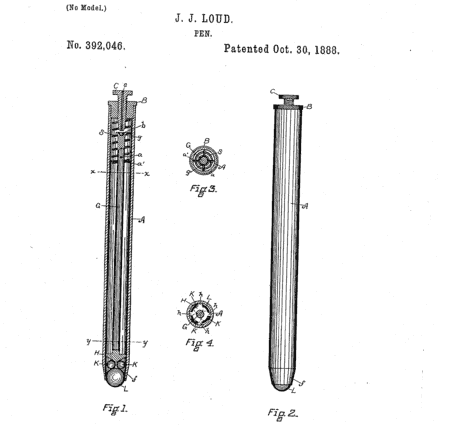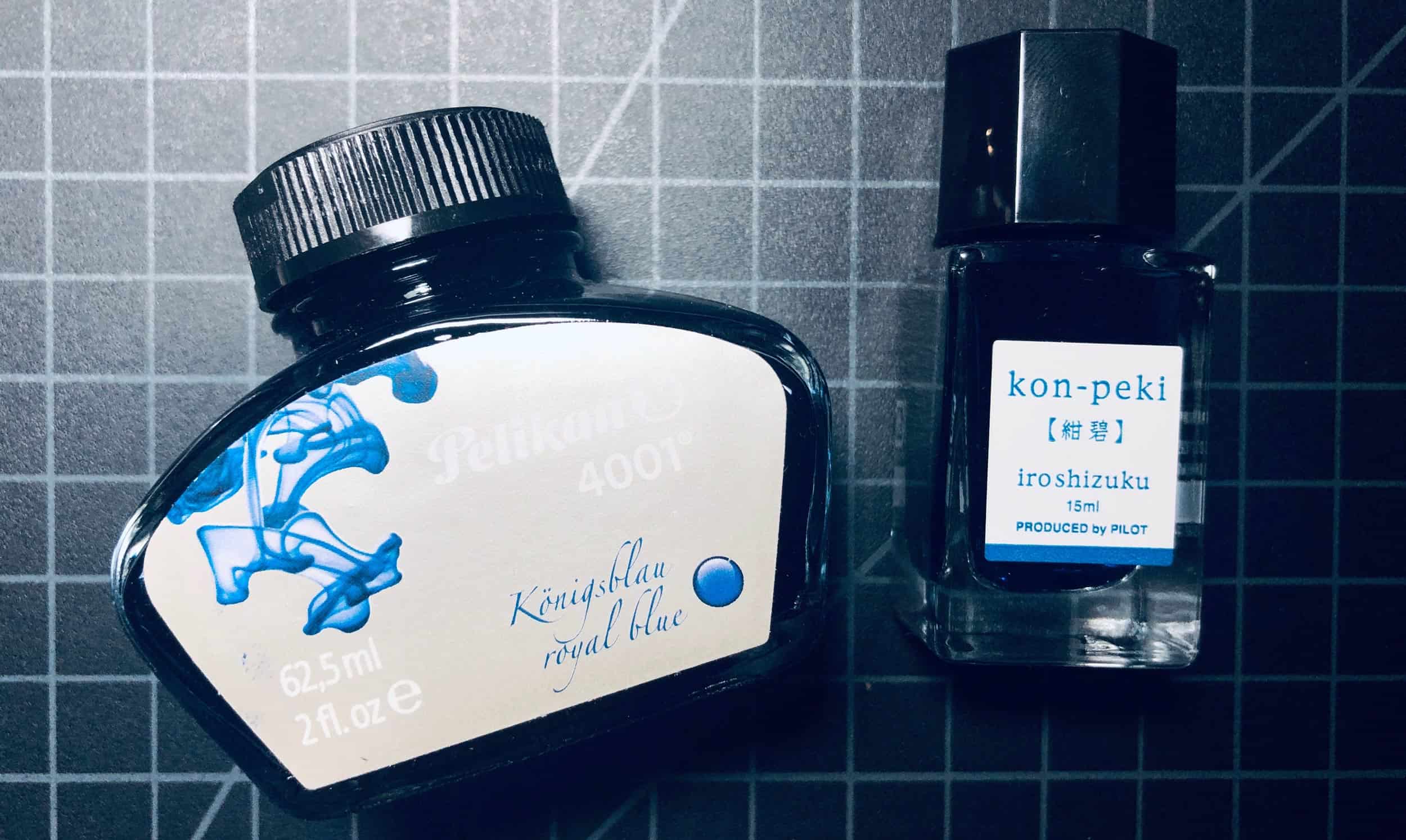When you start to dig into pens just a little bit you’ll see that they are separated ink a few major varieties based on the type of ink they use. These categories are blurry and ultimately not very well defined, but it’s helpful to know the basics about them so you have some idea of what you are buying. This guide will run through the major types of inks in order to help you get a better understanding of the major types of pens, how they write, why you might prefer one over the others, and the best uses for each.
Don’t miss our Pen Refills Guide so you can learn about the types of refills these inks go into.
Ballpoint Ink
 Ballpoint was, for a long time, the typical ink you’d see in a disposable pen. Ballpoint ink is oil-based. The ink itself is thick and sludgy, and if your ballpoint every exploded you’d see a very small amount of ink ooze out and you’d find that it’s incredibly difficult to clean off of anything. This is the ink in a Bic Cristal and other super popular pens.
Ballpoint was, for a long time, the typical ink you’d see in a disposable pen. Ballpoint ink is oil-based. The ink itself is thick and sludgy, and if your ballpoint every exploded you’d see a very small amount of ink ooze out and you’d find that it’s incredibly difficult to clean off of anything. This is the ink in a Bic Cristal and other super popular pens.
The first ballpoint pen was patented by John Loud in in October 1888 (file in February 1888) in US Patent 392,046. Loud noted that his invention was particularly good at writing on rough surfaces, like course wrapping paper, where a fountain pen would fail. He specifically describes the ball (the “marking sphere”) being at the end of a drawn down tube filled with ink.
There are limitless formulas for ballpoint pen ink, but the basic formula is an oil base and a dye or pigment suspended in that base. This could be carbon black for black ink or phthalocyanine blue for blue ink, or any number of color agents.
The oils can vary as well, but far less than the colors. In fact, 2-Phenoxyethanol is said to be used in 85% of blue and black inks (based on a limited size sample).
The strengths of ballpoint ink are that it will write on most surfaces, including a glossy surface like a magazine cover, and that the ink refills last for huge distances, up to 8000 meters of writing in some cases. The downsides of ballpoint ink include slow drying times, a lack of smoothness when writing, and less of a color sprectrum than other ink varieties.
Rollerball Ink
Rollerballs are the smooth, bold pens that many people gravitate towards as they start to learn more about pens. This is more of a fountain pen type experience with broad links and wet writing tips.
Rollerballs use a water-based (known as a “liquid ink”) or gel-based ink which explains why the ink can bleed on paper and feel loose or even runny. The loose ink means a thin tip is possible, so 0.5 mm rollerballs are not uncommon, where this would be quite thin for a ballpoint (though far from impossible).
The Japanese company Ohto was the first company to release a rollerball pen. They released a liquid-based ink in 1963, marking the start of the rollerball.
The advantages of rollerball pens are they are quite smooth and that their colors have the best range and brightest tones of any ink. The downside that the ink tends to want to sink into the writing surface, not sit on top of it (like a ballpoint or pencil) so they do not work well with glossy surfaces. Rollerballs are also prone to drying out when not left capped, which is not an issue with ballpoints. Capless rollerballs will dry out more slowly, but then they only have a year or so of life to them when uncapped. The watery ink is most likely to bleed through cheap or light paper than a ballpoint or pencil.
A liquid ink will put the most ink down on a writing surface, which is why these pens tend to wear out the fastest. Liquid inks tend to come in larger pens and larger refills to compensate for their quick usage of ink.
Rollerballs are standardized under ISO 14145-1 and ISO 14145-2.
Gel Ink
As noted above, gel inks are a type of rollerball ink. Rather than having a water base, the ink is gelled. The advantage of using a gel is that more pigment or dye can be used in the ink, making for brighter colors. A gel ink can also carry a metallic tone or sparkle, where other ink types cannot.
A gel ink is composed of a pigment (or pigments),water, and a thickening agent. This agent can be something common like xanthan gum or any number of other materials. The use of a pigment means that the colors can not easily be washed out of paper, as they can be with a dye.
Gel ink is said to have been invented by the Japanese company Sakura in 1984.
A gel ink an be up to 80% water which means smooth writing but a very limited writing distance.
Hybrid Ink
Hybrid ink is one of the more confusing ink varieties. There is no standard definition for a hybrid, but there are commonly accepted trades. Furthermore, many companies (especially in Japan) still call their hybrid inks “ballpoint ink” which adds greatly to the confusion.
Hybrid ink is the blend of ballpoint and rollerball inks. This means the ink is both water- and oil-based. This usually feels like a modern ballpoint ink, which is to say smooth like a gel but with the qualities of a ballpoint.
The hybrid ink type is usually most closely associated with the Uni Jetstream line, which is one of the earliest mainstream pens to feature a modern ballpoint ink.
Hybrid inks tend to be quick-drying and have strong colors, but also be able to write on all sorts of surfaces, including gloss. They don’t tend to do this as well as a traditional ballpoint, but the will be better than a purely water-based ink.
Another popular option in the hybrid market is the Pilot Acro, with great pens like the Acro 300 and Acroball. These are close competitors to the Jetstream but haven’t become as popular outside of Japan.
Fountain Pen Ink
Fountain pen ink is another loosely defined type of ink. It is, of course, the ink used in fountain pens, but it takes thousands of forms. The ink can be in a bottle or cartridge, it can be iron gall or water-based, it can be handmade or produced by the vat, it can be lubricated, fluorescent, quick-drying, or any number of other qualities, making this type of ink hard to define.
Fountain pen inks are water-based with color almost always coming in the form of dye. Some inks, like Sailor Kiwa-Guro, use pigments for color, but older versions of inks with pigments could clog feeds that rely on capillary action of the ink in order to flow.
Fountain pen inks are a looser, more watery consistency compared to all other pen inks. This means they are free-flowing and prone to splashing, forming droplets, and doing other things that have been known to ruin countless shirts. This ink is almost always non-corrosive, give the price and focus on longevity of most fountain pens. A notable exception to this is iron gall inks, but those have been around for hundreds of years, before fountain pens were a concern.
Sparkle Ink
In almost all cases sparkle ink is simply gel ink with powdered aluminum added to it.
